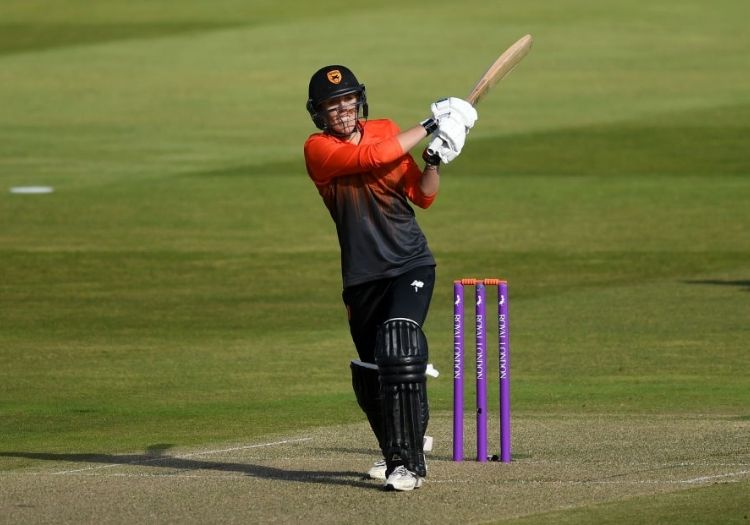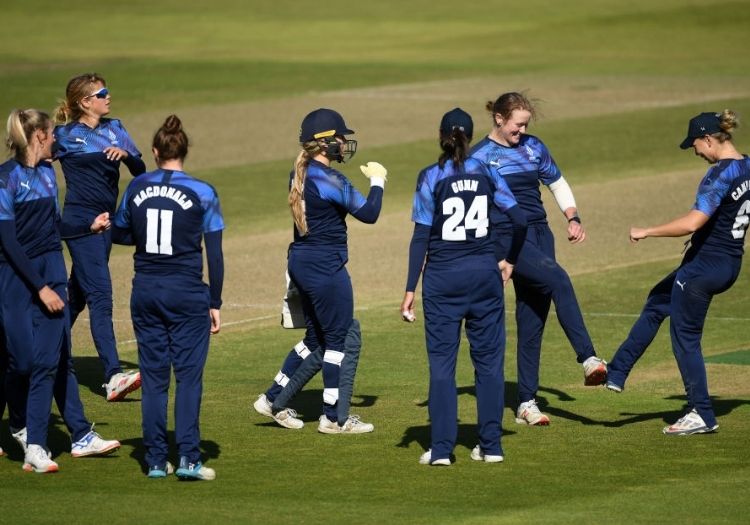NICK FRIEND: Having wondered whether she was destined "to just become a county cricketer", Adams has set the tone – not only for herself, but for several others who might have questioned whether they had a place in the domestic game's new era

When Tom Harrison spoke on Saturday morning about the Rachael Heyhoe Flint Trophy, his sense of pride was evident.
“To get that up and running has been super-important to us,” he said, breaking into a half-smile as he cast his mind back upon a frankly unprecedented turn of events that have taken the game from its highest ebb to the brink of full-blown crisis.
When a major investment in the women’s game and subsequent overhaul of the domestic structure were outlined this time last year, this was not part of the masterplan. Even in March, before the magnitude of the pandemic’s impact on the cricket season was fully understood, blank faces would have met mention of a competition bearing the name of Heyhoe Flint, an icon of the women’s game.
It was only on August 11 when an ECB press release dropped into inboxes across the cricketing fraternity that the competition’s existence was announced. The small matter of 47 days later, an Edgbaston final, featuring Southern Vipers and Northern Diamonds.
For Harrison, the source of the thrill was straightforward; having initially pitched a revamp of women’s domestic cricket in time for this season, he was determined to see his pledge through. When coronavirus threatened to pull the plug on the summer, the easier call might have been to postpone any grand projects by 12 months – the contracts, the regional hubs, the appointments of head coaches.
Instead, English cricket ploughed on. “It might not have been the start we absolutely wanted it to be,” Harrison continued, “but we’ve got it up and running and it has started to achieve some of the things that we need so desperately to achieve for the women’s pathway.”
A six-game round-robin followed by a showpiece final might not sound like much, but given the context of a campaign that could only begin on the Bank Holiday weekend at the end of August, it has represented a considerable achievement.
Georgia Adams has flown the flag for a generation of players on the women’s domestic circuit who have put in plenty of groundwork without much reward. Others, too, like Sophie Luff, Eve Jones, Hollie Armitage and Marie Kelly have offered important reminders that, for all the talk of development and youth pathways, they remain among the domestic circuit’s most consistent performers. Today, 26-year-old Charlotte Taylor added her name to that list with a six-wicket haul. Unheralded but undeterred, she wasn't even part of her region's squad until two months ago.
And then, there have been those at the other end of the spectrum, just starting out on their journeys. Ella McCaughan only turned 18 on Saturday, but she proved a mightily effective foil for Adams at the top of the Vipers’ order. Sixteen-year-old Alice Capsey showed several glimpses of her potential in a youthful South East Stars side.

Georgia Adams ends as the top run-scorer in the Rachael Heyhoe Flint Trophy
As for the Bryce sisters, Kathryn, 22, ended with 14 wickets; Sarah, two years younger at 20, scored 395 runs at an average of 79, passing fifty in all but one of her six matches. A remarkable feat for the Scottish siblings.
For Alex Hartley and Tash Farrant, both of whom have lost central contracts in recent times, these have been significant months. The pair are important symbols of the ECB’s push towards professionalisation in the women’s game and a world where cricket can remain a viable career choice beyond the top table.
Upon being offered her retainer deal, Hartley, who had struggled for motivation in the aftermath to being let go by England, told The Cricketer that the introduction of domestic contracts meant “it’s not the end of the road anymore” for those in her position.
Speaking to The Cricketer in June, Farrant recalled losing her own England deal. “When it all came crashing down, my whole world was gone,” she said. Like Hartley, she is back in the picture now. Both left-armers captained their respective regions in this year’s tournament, giving both an opportunity to make the most of their considerable experience.
Susie Rowe’s return to the fold is another similar tale – a journey reflective of the wider trajectory of the women’s game. Having played her final game for England in 2013, she left the sport in 2015 to pursue her passion for hockey, frustrated by the lack of infrastructure beyond the international game. She was no longer enjoying the county game and felt on a personal level that her ambitions lacked any sense of purpose or direction.
And so, her rebirth with South East Stars, having been tempted into a renaissance by the dangled carrot of The Hundred, is another feather in the cap for a much-needed domestic facelift. Rowe, 33, won’t play for England again – a fact she has long-since come to accept, but her willingness to return is proof of the feeling that more exists now, that there was something to come back to.
“Coming back to the game, it’s just unrecognisable and it’s brilliant to be part of,” she told The Cricketer last week. “I wish this was around when I left the game; I probably wouldn’t have left, with all these setups in place.”
Perhaps, that notion has emerged as the greatest success story of this shortened summer. A televised final on Sky Sports is the tip of the iceberg – a pinnacle of visibility in the women’s domestic 50-over game, featuring several players who have never enjoyed this kind of exposure.
Adams’ achievements, therefore, have felt particularly poignant. Until she swept Katie Levick to the fielder at deep midwicket when well set on 80, the Vipers captain was seemingly on course for a hundred of almost startling inevitability. Her dismissal means that she finishes the competition with 500 runs – 105 more than her nearest rival, a quite terrific effort in just seven white-ball innings.

Charlotte Taylor took six wickets for Southern Vipers in the final
In the last decade, only one female player has made an England debut past the age of 25 – Sonia Odedra in her solitary Test appearance against India in 2014 as a 26-year-old. The last debutant over the age of 30 was Ruth Lupton – 25 years ago. It remains to be seen what professionalisation at domestic level means, but Adams and her peers will hope that it opens door that have, in recent times, appeared shut.
During lockdown, she spoke to The Cricketer about precisely this issue, well before she had produced a set of Bradmanian numbers to back up her claim.
“I do feel like there has been this culture within the women’s game that if you’ve not broken into the England setup before you’re 22, you’ll struggle,” she admitted.
“You’re not in the academy, you’re out of the pathway, you’re probably not going to play for England. I don’t know whether it’s just my love of cricket, but there was always something that kept me going. I wasn’t ready to let it go yet or to have any ‘what ifs’.
“I didn’t want to just become a county cricketer and not train and not dedicate myself to being as good as I can be.
“If you’d said two or three years ago that domestic cricket was going to go professional, I’d have laughed. I guess now, I’m just chuffed that I did keep working at it and keep going because I think now if you have a good season, they know that we’re training with high-quality staff and in brilliant environments.”
And having enjoyed a month like this, higher honours would be fine reward for a stalwart who has never stopped in pursuit of her dreams. She was namechecked by Heather Knight in a recent interview with ESPNcricinfo, while her time as part of England Academy squads overlapped with Lisa Keightley’s previous stint in charge.
Her run tally has also benefited from a month spent on the quality of pitches that come with playing at first-class venues. In the County Championship – the women’s previous 50-over competition, reaching 200 granted sides the maximum number of bonus points available. That barrier was breached 30 times in this tournament – a figure that lays bare an obvious improvement.

Northern Diamonds fell 38 runs short
“I think playing at these big grounds, players know how many runs they’ve scored there and know what they’re averaging there,” Vipers analyst George McNiel told The Cricketer ahead of the final.
“On a psychological level, they get up for the game a lot more – if they turn up playing at The Oval rather than at the Aldridge Academy, where there are no stands, I think it’s massive for them.”
And on the biggest day of all, Vipers held their nerve. The game itself was hardly a classic; at one stage, Adams’ knock threatened to turn the occasion into a procession.
But once she holed out, a fairly tame collapse opened the door for Diamonds, who were strengthened by England’s decision to allow Lauren Winfield-Hill to leave the bio-secure bubble and take her place as captain of her side.
Yet, after she and Armitage both fell when well set, Ami Campbell, Alex McDonald, Jenny Gunn and Bess Heath contributed three ducks and nine runs between them – a surrender of 5 for 22 in eight overs that all but sealed the fate of Danni Hazell’s side.
Taylor was rewarded for bowling consistently straight with an extraordinary set of figures – the best of her life, she suggested afterwards. She became the tournament’s top wicket-taker in the process. When Sterre Kalis fell, the Dutch international making her third successive half century after beginning the tournament with three ducks, the game was over as a contest.
Fittingly, it was left to Adams, palpably the player of the tournament, to take the final wicket and then to lift a trophy that didn’t even exist a matter of weeks ago. For a competition put together as an emergency measure, that was an appropriate ending.
Having wondered whether she was destined “to just become a county cricketer”, Adams has set the tone in the last month – not only for herself, but for several others who might have questioned whether they had a place in the domestic game’s new era.
For unrivalled coverage of the county season, subscribe to The Cricketer and receive 3 issues for £5